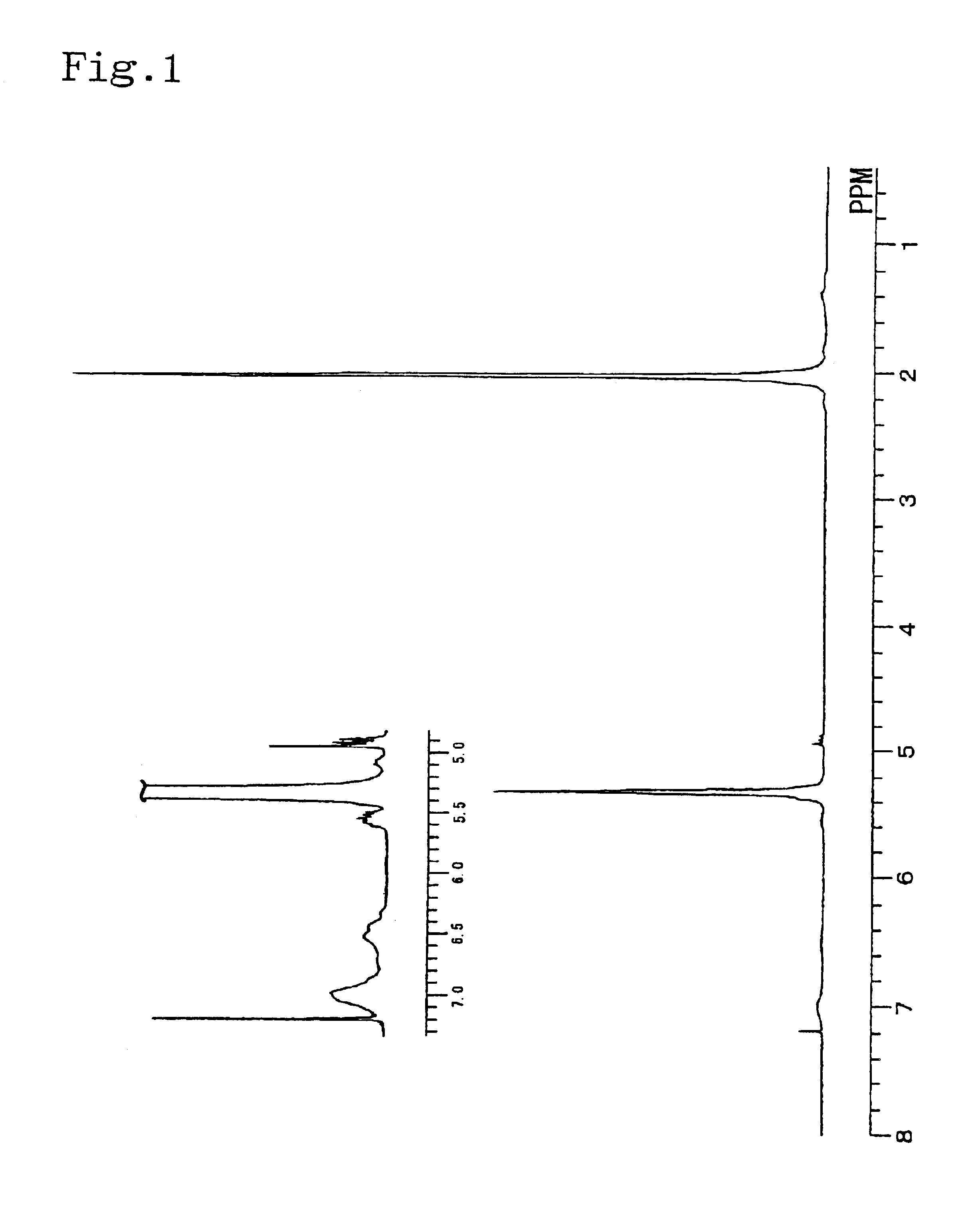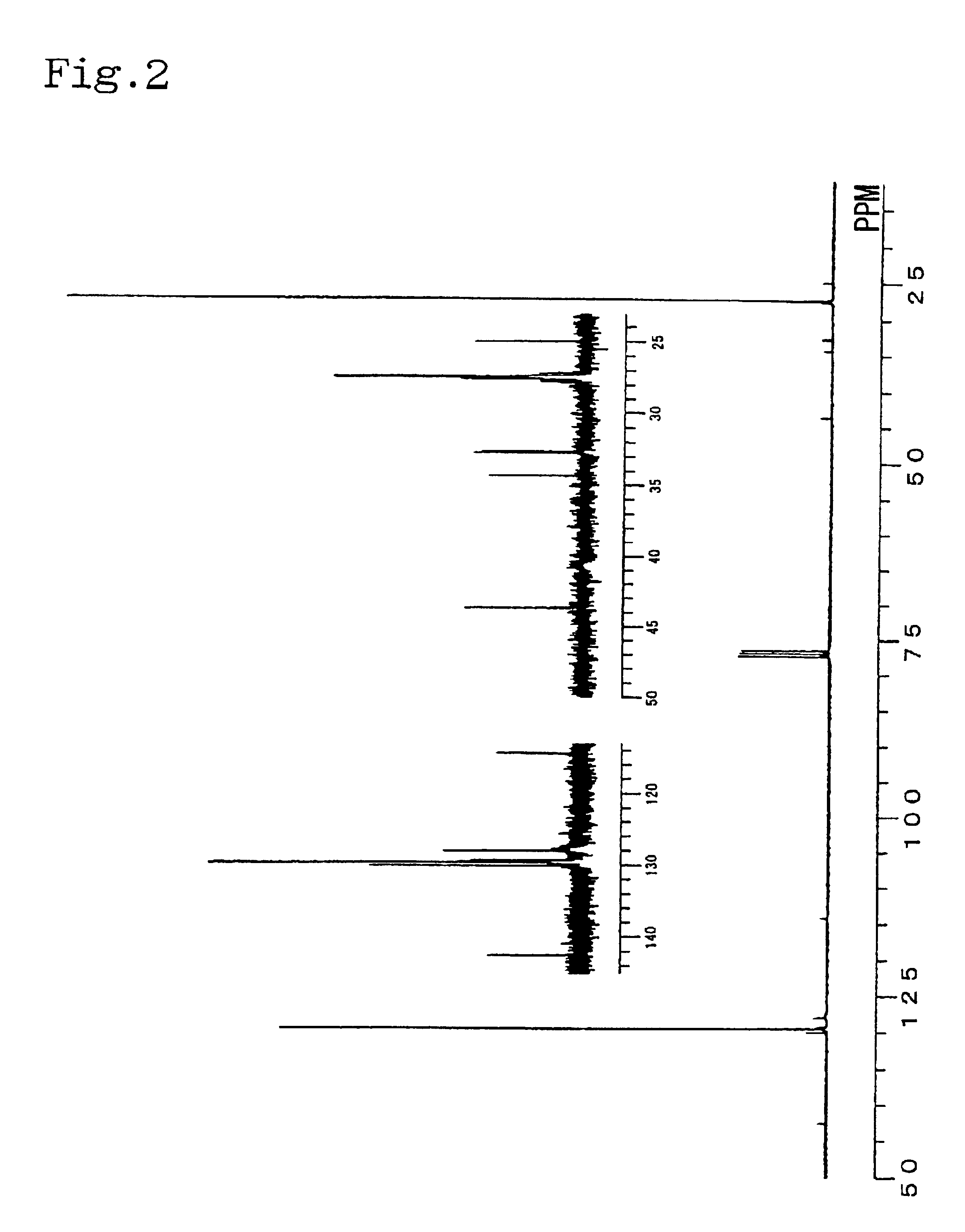Catalyst composition and process for producing copolymer
a technology of catalyst composition and copolymer, which is applied in the direction of catalyst activation/preparation, physical/chemical process catalysts, chemical/physical processes, etc., can solve the problem of difficult to control the stereoregularity of conjugated diene moieties of copolymers, polymers with a high molecular weight and narrow molecular weight distribution, and copolymers with randomized monomer sequence cannot be obtained by means of these catalysts. problem, to achiev
- Summary
- Abstract
- Description
- Claims
- Application Information
AI Technical Summary
Benefits of technology
Problems solved by technology
Method used
Image
Examples
example 1
[0054]In a glove box under nitrogen atmosphere, 0.05 mmol of dimethylaluminum(μ-dimethyl)bis(pentamethylcyclopentadienyl) samarium [(Cp*)2Sm(μ-Me)2AlMe2](Cp*:pentamethylcyclopentadienyl ligand) was put into a sufficiently dried 30-ml pressure glass bottle and dissolved in 9 ml of toluene. Then, 0.15 mmol of triisobutylaluminum and 0.05 mmol of triphenylcarbonium tetrakis(pentafluorophenyl)borate (Ph3CB(C6F5)4) were added into the bottle, and the bottle was sealed with a stopper. The bottle was then taken out from the glove box and 0.27 g of 1,3-butadiene was put into the bottle, and polymerization was carried out at −20° C. for 10 minutes. The polymerization product was sampled at this stage, and it was found that the product had a butadiene addition ratio of 98%, weight average molecular weight of 55,400, number average molecular weight of 45,000 and Mw / Mn of 1.23. Then, 0.6 ml of styrene was added to the bottle, and polymerization was further carried out at −20° C. for 5 hours. Af...
example 2
[0055]In a glove box under nitrogen atmosphere, 0.01 mmol of dimethylaluminum(μ-dimethyl)bis(pentamethylcyclopentadienyl) samarium [(Cp*)2Sm(μ-Me)2AlMe2] was put into a sufficiently dried 100-ml pressure glass bottle and dissolved in 30 ml of toluene. Then, 0.03 mmol of triisobutylaluminum and 0.01 mmol of triphenylcarbonium tetrakis(pentafluorophenyl)borate (Ph3CB(C6F5)4) were added into the bottle, and the bottle was sealed with a stopper. The bottle was then taken out from the glove box, and 1.70 g of 1,3-butadiene was put into the bottle. Polymerization was carried out at 50° C. for 10 minutes. Then, 5.0 ml of styrene was added to the bottle, and polymerization was further carried out at 50° C. for 5 hours. After the polymerization, 10 ml of methanol containing 10 wt % BHT [2,6-bis(tert-butyl)-4-methylphenol] was added to the reaction system to stop the reaction. The polymer was separated by using a large amount of 2-propanol and dried at 60° C. in vacuo. The amount of the resul...
example 3
[0056]In a glove box under nitrogen atmosphere, 0.01 mmol of dimethylaluminum(μ-dimethyl)bis(pentamethylcyclopentadienyl) neodymium [(Cp*)2Nd(μ-Me)2AlMe2] was put into a sufficiently dried 30-ml pressure glass bottle and dissolved in 6 ml of toluene. Then, MMAO (toluene-soluble aluminoxane sold by TOSOH and Akzo Co.) was added into the bottle so that the elemental ratio Al / Nd became 200, and the bottle was sealed with a stopper. The bottle was then taken out from the glove box, and 1.5 g of 1,3-butadiene was put into the bottle. Then, polymerization was carried out at 50° C. for 5 minutes. After the polymerization, 10 ml of methanol containing 10 wt % BHT [2,6-bis(tert-butyl)-4-methylphenol] was added to the reaction system to stop the reaction. The polymer was separated by using a large amount of a mixed solvent of methanol / hydrochloric acid and dried at 60° C. in vacuo. The yield of the resulting polymer was 66 wt %. The cis-content in the microstructure of the polymer was 97.5 mo...
PUM
| Property | Measurement | Unit |
|---|---|---|
| atomic numbers | aaaaa | aaaaa |
| temperature | aaaaa | aaaaa |
| temperature | aaaaa | aaaaa |
Abstract
Description
Claims
Application Information
 Login to View More
Login to View More - R&D
- Intellectual Property
- Life Sciences
- Materials
- Tech Scout
- Unparalleled Data Quality
- Higher Quality Content
- 60% Fewer Hallucinations
Browse by: Latest US Patents, China's latest patents, Technical Efficacy Thesaurus, Application Domain, Technology Topic, Popular Technical Reports.
© 2025 PatSnap. All rights reserved.Legal|Privacy policy|Modern Slavery Act Transparency Statement|Sitemap|About US| Contact US: help@patsnap.com



